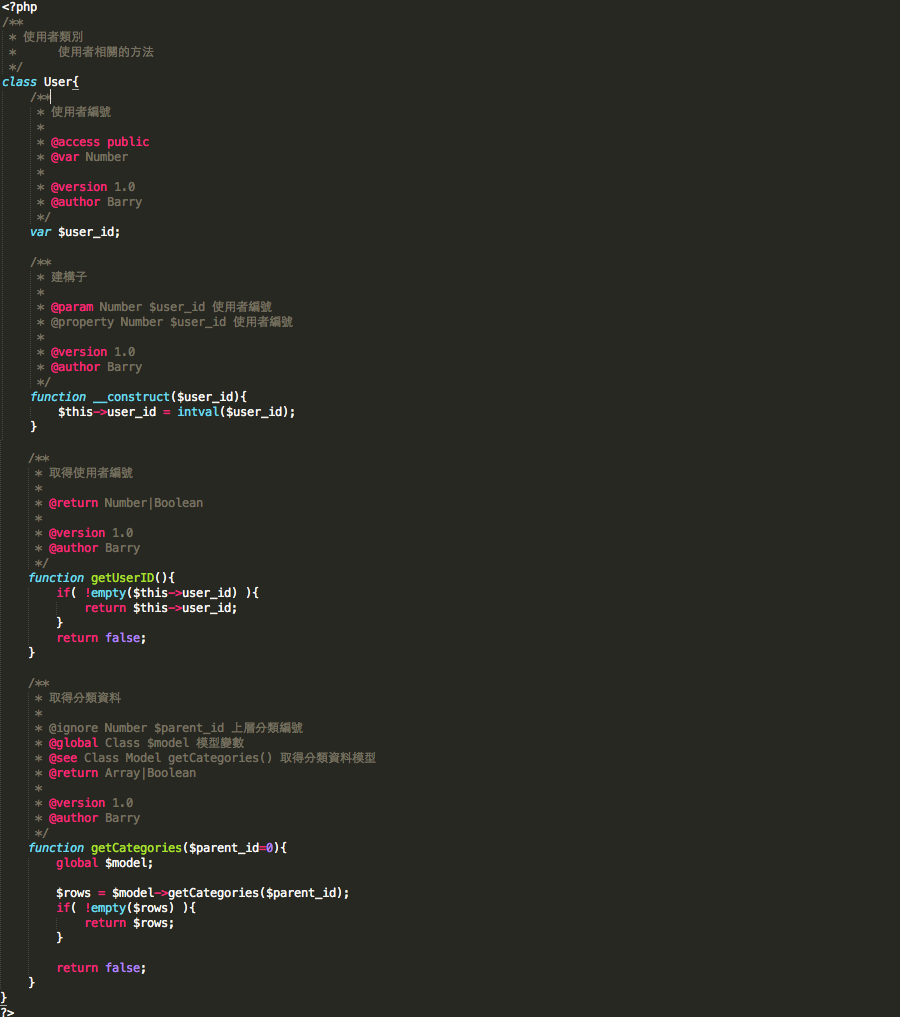/** * 函數名稱 * 函數描述(有些會含HTML代碼) * * @access 變數可存取的權限 (Example: Public or Private) * @api 爲第三方來源的變數 * @author 函數建立者名稱 (Example: @author Barry <riceooks[at]gmail.com>) * @category 函數的分類別名,可能某些工具會利用這個來分類你的方法,使好幾個方法歸為某一類,方便做辨識使用 * @copyright 函數的版權宣告 (Example: @copyright 隨手寫有限公司 www.barryblogs.com) * @deprecated 代表不建議使用的函數,未來可能會移除這個方法使用到的某個變數,或整個方法都被刪除 * @example 代表這個函數使用方式可以參考某個資料,可以使用檔案位置或網址 (Example: @example https://www.barryblogs.com/) * @filesource 這個函數所需的來源 * @global 函數內有使用的全域變數註解 (Example: @global Number $user_id) * @ignore 代表這個函數或區域可以被忽略,通常會加上說明 * @internal 代表這個函數或區域可能只給予內部使用 * @license 此函數可能是含有某個版權或許可 (Example: @license http://opensource.org/licenses/gpl-license.php GNU Public License) * @link 可能與某個網站有關係 (Example: @link https://www.barryblogs.com/) * @method 函數有使用的方法 (Example: @method Array @this->getCategories() or @method String getUserName()) * @package 利用這個註解來達到細部分層結構 (Example: @package PSRDocumentationAPI or @package PSRDocumentationDoc) * @param 函數要帶入的參數 (Example: @param String|Number $username) * @property 如果這是一個類別的函數,在類別建構時通常會指定初始化參數,而這個函數可能會使用到某些初始化後的參數,稱之為屬性 (Example: @property Resource|Boolean $mysql_connect) * @return 函數最後的回傳值或形態 (Example: @return Array|Object|Boolean) * @see 函數參照或關聯的方法 (Example: @see Class User or @see <a href="https://www.barryblogs.com/">BarryBlogs</a>) * @since 函數內某個使用的變數由哪個版本變動 (Example: @since v1.3376a $user_nickname ) * @source 這個比較特別,在函數中可以標示從 m 至 n 行 是做什麼事情 (Example: @source 14 21 Get user data) * @static 靜態變數的註解 (Example: @static String $lang = 'zh_TW') * @subpackage 利用這個註解來達到細部分層子結構,通常會同時使用 @package,可以參考上面的@package (Example: @package PSR * @subpackage DocumentationAPI) * @throws 例外處理的註解,有多種例外處理的方式,每種方式都不同 (Example: @throws InvalidArgumentException if the provided argument is not of type 'array' * @throws Exception other...) * @todo 計劃要進行的項目描述,一般應該會使用文字描述 * @uses 代表某個元素可能與其它結構有利用關係 (Example: @uses MyClass::$items to retrieve the count from) * @var 變數(物件成員變數)的形態或描述 (Example: @var Boolean) * @version 函數的版本 (Example: v1.3258c) */
/** * 使用者類別 * 使用者相關的方法 */ class User{ /** * 使用者編號 * * @access public * @var Number * * @version 1.0 * @author Barry */ var $user_id; /** * 建構子 * * @param Number $user_id 使用者編號 * @property Number $user_id 使用者編號 * * @version 1.0 * @author Barry */ function __construct($user_id){ $this->user_id = intval($user_id); } /** * 取得使用者編號 * * @return Number|Boolean * * @version 1.0 * @author Barry */ function getUserID(){ if( !empty($this->user_id) ){ return $this->user_id; } return false; } /** * 取得分類資料 * * @ignore Number $parent_id 上層分類編號 * @global Class $model 模型變數 * @see Class Model getCategories() 取得分類資料模型 * @return Array|Boolean * * @version 1.0 * @author Barry */ function getCategories($parent_id=0){ global $model; $rows = $model->getCategories($parent_id); if( !empty($rows) ){ return $rows; } return false; } }

